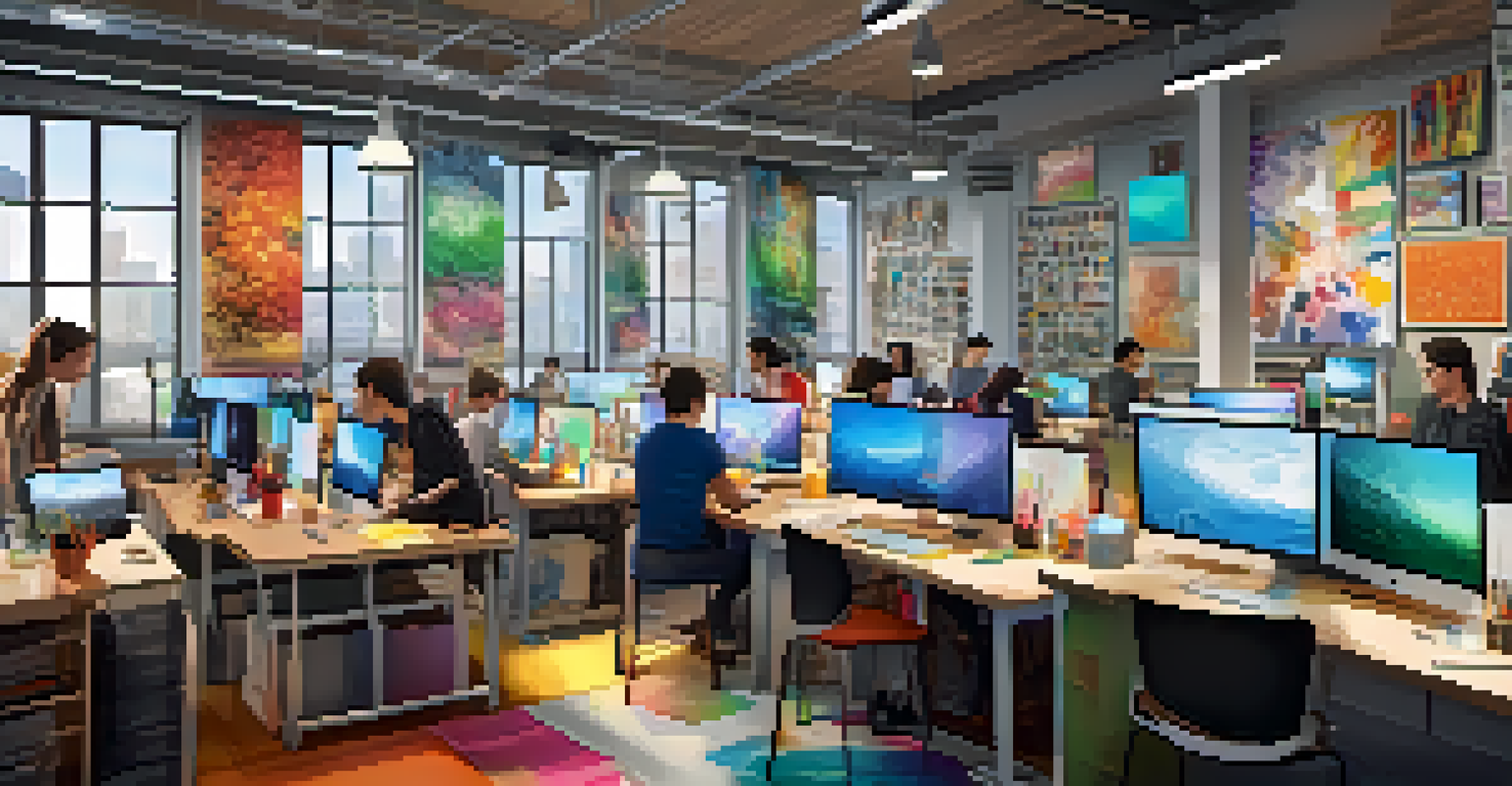Cross-Disciplinary Learning in STEAM: Benefits and Strategies

Understanding Cross-Disciplinary Learning in STEAM
Cross-disciplinary learning in STEAM (Science, Technology, Engineering, Arts, and Mathematics) involves integrating knowledge and skills from various fields to enhance education. This approach encourages students to see connections between different disciplines, fostering a more holistic understanding of complex concepts. For instance, a project that combines art and engineering can inspire creativity while teaching critical problem-solving skills.
Creativity is thinking up new things. Innovation is doing new things.
By blending subjects like mathematics and visual arts, students can visualize abstract concepts, making them more accessible and engaging. This kind of learning reflects real-world scenarios, where problems often require input from multiple disciplines. Thus, cross-disciplinary learning not only enriches the educational experience but also prepares students for the multifaceted challenges of the modern workforce.
Furthermore, this method promotes collaboration among students, teaching them to value diverse perspectives. As they work together on projects that draw from various areas of knowledge, they develop essential teamwork and communication skills. Ultimately, cross-disciplinary learning in STEAM cultivates a generation of innovative thinkers who are ready to tackle the complexities of the future.
The Benefits of Cross-Disciplinary Learning
One of the most significant benefits of cross-disciplinary learning is the enhancement of critical thinking skills. When students are encouraged to draw connections between different subjects, they learn to approach problems from various angles. This multifaceted viewpoint not only sharpens their analytical abilities but also fosters creativity as they brainstorm innovative solutions.

Additionally, cross-disciplinary learning caters to different learning styles. Some students may excel in artistic expressions, while others might prefer logical reasoning. By incorporating multiple disciplines, educators can engage a wider range of students, ensuring that everyone has the opportunity to thrive and contribute meaningfully to the learning process.
Enhances Critical Thinking Skills
Cross-disciplinary learning encourages students to connect different subjects, fostering critical thinking and innovative problem-solving.
Moreover, this approach can spark a lifelong love for learning. When students see how different subjects relate to their interests and the world around them, they become more invested in their education. This intrinsic motivation can lead to greater academic achievement and a desire to explore new fields, both in and out of the classroom.
Strategies for Implementing Cross-Disciplinary Learning
To implement cross-disciplinary learning effectively, educators should start by designing integrated projects that align with curriculum goals. For example, a project might involve creating a digital art piece that illustrates a scientific concept. By setting clear objectives and outcomes, teachers can guide students while allowing them the freedom to explore their creativity.
The future belongs to those who believe in the beauty of their dreams.
Collaboration between teachers from different disciplines is also crucial. When educators work together to create cohesive lesson plans, they can provide students with a more comprehensive understanding of the subject matter. Regular meetings and brainstorming sessions can help foster this collaboration, leading to innovative teaching methods and shared resources.
Finally, incorporating technology can enhance cross-disciplinary learning experiences. Tools such as interactive simulations, design software, and online collaboration platforms can facilitate creative projects that span multiple subjects. By leveraging technology, educators can create dynamic learning environments that engage students and prepare them for a technology-driven future.
Fostering Creativity through Cross-Disciplinary Projects
Creativity is often the spark that drives innovation, and cross-disciplinary projects are a fantastic way to ignite that spark in students. By combining elements from different fields, students can explore unique avenues for expression. For example, a project that merges science and theater could involve creating a play about environmental issues, allowing students to articulate complex ideas in an engaging manner.
These creative endeavors not only enhance students' understanding but also build their confidence. When students see their ideas come to life through cross-disciplinary projects, they develop a sense of accomplishment. This boost in self-esteem can motivate them to take on new challenges and pursue their interests more passionately.
Prepares Students for Real-World
This educational approach equips students with skills needed for interdisciplinary collaboration in diverse industries.
Moreover, fostering creativity in the classroom encourages a growth mindset. Students learn to embrace failure as a part of the learning process, understanding that experimentation and iteration lead to success. This resilience is an invaluable skill that will serve them well in all areas of life, whether in school, work, or personal pursuits.
Real-World Applications of Cross-Disciplinary Learning
Real-world applications of cross-disciplinary learning can be seen in various industries, from technology to healthcare. For instance, in the tech industry, professionals often collaborate across disciplines to develop innovative products. Engineers, designers, and marketers must work together to create solutions that are not only functional but also user-friendly and appealing to consumers.
Similarly, the field of healthcare benefits from cross-disciplinary learning, where doctors, researchers, and even artists come together to improve patient care. By integrating knowledge from various disciplines, healthcare professionals can develop comprehensive treatment plans that address the physical, emotional, and social needs of patients. This holistic approach ultimately leads to better health outcomes.
These examples highlight the importance of preparing students for careers that require interdisciplinary collaboration. By providing them with cross-disciplinary learning experiences in school, educators equip students with the skills necessary to thrive in diverse work environments. This preparation not only enhances their employability but also empowers them to become active contributors to society.
Challenges in Cross-Disciplinary Learning and Solutions
While cross-disciplinary learning offers numerous benefits, it also comes with challenges. One common issue is the difficulty in coordinating schedules between teachers from different disciplines. This can lead to missed opportunities for collaboration, making it essential for schools to prioritize and facilitate interdisciplinary planning.
Another challenge is ensuring that students remain focused and engaged throughout cross-disciplinary projects. Sometimes, students may struggle to see the relevance of combining different subjects, leading to disinterest. To mitigate this, educators can emphasize real-world connections and the practical applications of their projects, helping students understand the value of their work.
Fosters Lifelong Learning Motivation
By linking subjects to their interests, cross-disciplinary learning instills a love for education and intrinsic motivation.
Additionally, providing adequate resources and training for educators is crucial. Professional development opportunities can help teachers learn effective strategies for integrating disciplines and managing interdisciplinary projects. By investing in teacher training, schools can create a supportive environment that fosters successful cross-disciplinary learning experiences.
The Future of Cross-Disciplinary Learning in Education
The future of cross-disciplinary learning in education looks promising as more institutions recognize its value. As the world becomes increasingly interconnected, the ability to think across disciplines will be essential for future generations. Educators are beginning to embrace this shift, designing curricula that reflect the complexities of real-world problems.
Moreover, advancements in technology will continue to play a pivotal role in facilitating cross-disciplinary learning. Tools that enable virtual collaboration and interactive learning experiences can help bridge the gap between subjects, making education more engaging and relevant. As technology evolves, so too will the opportunities for innovative cross-disciplinary projects.

Ultimately, the success of cross-disciplinary learning will depend on a collective effort from educators, administrators, and policymakers. By prioritizing this approach and fostering an environment that encourages collaboration, we can prepare students to navigate the complexities of the future with confidence and creativity.